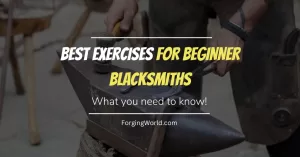While I was still finishing the last knife for today, the idea for a new article popped up in my mind. Since I see a lot of questions regarding the ideal anvil size for knife making, I decided to write this article and make a detailed answer.
So, what is the best size anvil for knife making?
Typically, somewhere between 50 and 100 lb anvil is an ideal anvil size for knife making. The heavier it is, the better, as it will be more efficient to work on. If you plan on moving the anvil occasionally, don’t buy the anvil heavier than 100 lb. Any anvil you plan on using for knife-making should have a flat and hard steel face.
My Favorite Knife-Making Anvil Choices on the Market
For those who aren’t interested in too many details about why a certain anvil is good or not, I want to recommend the anvil I used for years and was genuinely delighted with it.
Now I use a much bigger and more expensive anvil because I thought my projects required so. However, lately, I’ve come to realize buying so huge and expensive anvil wasn’t necessary, even for someone who has been in this business for 20 years, like I did.
My favorite choice for projects like knife making:
Happybuy Single Horn Anvil 66Lbs
That would certainly be the anvil I would come back to at some point; however, I still require a bit heavier anvil than that because my projects involve heavier work. If you plan to expand your project to more than small stuff like knives, I would advise sticking with the same brand, just a bigger size.
Larger version for bigger blacksmithing projects:
Happybuy Single Horn Anvil 110Lbs
Now let’s dive into this in greater detail.
What to Look for in a Knife Making Anvil
Since an anvil serves as the working surface for every knife maker, it is crucial to choose the right one. When I was just getting started, a piece of scrap steel served me as an anvil. While I could somehow get the job done, it simply wasn’t sustainable to continue working on that. I needed something better.
So before buying the anvil, consider these factors:
- Anvil Mass
- Construction
- Portability
Anvil Mass
This one is vital. The heavier the anvil, the better, as your work will be more efficient. You can use the mass of the hammer as the reference point. For example, if you use the 2 lb hammer, you need at least 20x anvil heavier than that. The ideal mass ratio of anvil and hammer is around 50:1. So if you use the 2 lb hammer, you should have a 100 lb anvil.
While this is not a law, it is definitely a good reference point that can properly guide you toward choosing the right size. If your anvil bounces a lot during hammering, it is improperly mounted or simply too light.
Just don’t expect to work efficiently on a 20 lb anvil with a 4 lb hammer. While theoretically, it can work, it will make your forging session a nightmare in practice. Don’t ask me how I know that.
Construction
In terms of anvil construction, it can be either cast or forged. Typically, forged anvils are a superior choice mainly due to their higher hardness and toughness.
A good-quality forged anvil will last centuries while a cast anvil, unfortunately, won’t. If you go for a forged anvil, be prepared to spend more money than if you planned on buying the alternative.
Before presenting the possible materials, you should know the difference between the forging and casting processes.
Casting is when the metal is heated to extremely high temperatures until molten. When metal becomes liquid, it is poured into a specific mold. After that, it is simply left to solidify and cool.
On the other hand, forging is when a compressive force is used to form metal into the desired shape. The forging process creates much stronger and tougher anvils than casting. Forged anvils are much less likely to take the same amount of damage during hammering.
A typical anvil is usually made of steel, iron, or some combination of the two. While there are many ways of mixing iron and steel, welding the high-carbon steel on a wrought iron body is the most common.
Today, you will be most likely to find cast iron and wrought iron anvils on the market. If possible, you should avoid using pure cast iron anvils. While they may be good for starting purposes, they will usually not last very long unless they have a welded steel plate on top of the anvil. On the other side, you have wrought iron anvils that are commonly used for knife making.
Wrought iron is usually softer and more ductile. These types of anvils have a high level of fatigue resistance, making them a superior choice. However, both of them are susceptible to rust. If you want to make a drastic increase in the hardness and toughness of your wrought iron anvil, consider adding a steel plate on top.
Portability
The portability issue is often not considered when buying an anvil for knife making. So before you buy the anvil ask yourself, are you planning on moving it occasionally for some reason?
If the answer is yes, you should reconsider the mass of the anvil. For example, if you have blacksmithing shows every other weekend, don’t buy a 300-pound anvil. Imagine moving that monster every weekend. While it is possible, it isn’t convenient. You would need at least 2 people to help you out.
So, if you plan on moving your anvil every often or so, don’t buy an anvil heavier than 100 lb. The size of the anvil is an upper limit for transportation. If you are strong enough, you could even move it yourself. If not, you can always ask somebody to help you. Also, that anvil size is suitable for transport in a normal car.
Note that an anvil for bladesmithing doesn’t necessarily require a horn. The most important part is the face. I would recommend having a steel plate face at least 4×4″ of surface area. Depending on the size of the blades, the surface may need to be larger or smaller. I suggest having a larger face for sword making, while 4×4 is usually enough for smaller knives.
If you want to learn everything about blacksmithing anvils, check out our guide with everything you need to know about Anvils.
Easy Way to Test the Anvil
Okay, you bought the anvil, and now you want to see whether it was a good buy or not. What do you do?
While there are several ways of determining the quality of the anvil, the Steel Ball Test and the Hammer Rebound Test are the most practical. Both tests are relatively easy and don’t require any special testing equipment.
Steel Ball Test
To do the Steel Ball Test, you need a small steel bar, an anvil, and a ruler. The first thing you need to do is simply put the ruler vertically on the face of the anvil. Now, set the steel ball somewhere around 10 inches (25 cm) and drop it. Do not throw the ball, simply drop it. If you throw it down, it will make the test pointless as it will bounce higher.
Repeat this process several times in different places. Results may vary, depending on the mass of the anvil. Keep in mind that this is not a precise indicator of hardness but rather a solid estimate.
Hammer Rebound Test
The second test is called a Hammer Rebound Test. It is done by dropping the hammer’s head and observing the level of rebound. The higher the rebound is, the better. The first thing you want to do is place the hammer over the center of the anvil. Make sure that the handle is paraččeč to the anvil’s face.
Use the face, not the peen of the hammer. Now, drop the hammer and watch the rebound. A good result is anything above 1/3 of the initial distance. If the rebound is less than that, the anvil is probably cast iron.
An important thing to remember is that you shouldn’t strike the hammer. The reason is the same as in the previous test. It will produce a false result due to the increase in energy produced.
What are Anvil Alternatives for Knife Making?
If you cannot afford a “real” blacksmithing anvil, don’t worry because there are alternatives. Keep in mind that for knife-making purposes, London or German-style anvils are not even required. All you actually need is some hard and flat metal surface.
One of the best anvil alternatives is a piece of scrap steel. You can easily find it at construction sites, scrapyards, local businesses, and dumpsters. A high-carbon steel plate is a better option. However, it is a more expensive option, but it is worth the extra money.
Recommended reading:
The Railroad Track – Should You Use It As an Anvil?



